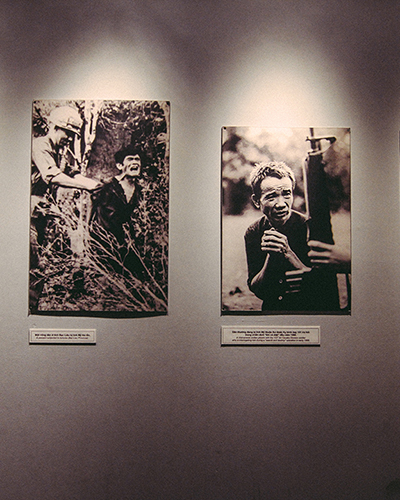War Remnants Museum
On August 31, 1858, the French attacked Da Nang, marking the beginning of their war of aggression and
colonial rule in Vietnam. For nearly 100 years the Vietnamese people fought with great fortitude for
national liberation. After the August Revolution, President Ho Chi Minh made a Declaration of Independence,
putting an end to French colonialism and asserting Vietnam’s right to independence. But the French
colonialists, and then American imperialists, persisted in their aggression and conspiracy to sustain
foreign domination over and introduce neo-colonialism to Vietnam. For 30 years the Vietnamese people,
courageous and strong, remained willing to sacrifices their lives for the sake of freedom.
.jpg)
.jpg)
History
April 30, 1975 saw the overwhelming victory of the Vietnamese people, and the restoration of peace and the
nation’s freedom, sovereignty and territorial integrity.
To cherish the memories of the Vietnamese people’s great heroism in their struggle against foreign
aggressions and to denounce the crimes and highlight the tragic consequences of those aggressions, the
Exhibition House for the Crimes of America and Its Puppet Government opened to the public on September 4,
1975. Its name was changed first into the Exhibition House for the Crimes of the Wars of Aggression on
October 11, 1990, and the War Remnants Museum on July 4, 1995.
.jpg)
Opening ceremony of the Exhibition House for the Crimes of America and Its Puppet Government on September 4,
1975
Now the War Remnants Museum is run by the Ho Chi Minh City Department of Culture and Sports. A member of the
Vietnamese museum network as well as the International Network of Museums for Peace (INMP) and International
Council of Museums (ICOM), it researches, collects, preserves, and displays documents, photos and artefacts
revealing the crimes committed during the wars of aggression against Vietnam and their consequences. This is
how the Museum has decided to educate the public, especially young generations, about the spirit of struggle
for national independence, the sense of opposition to the wars of aggression and safeguarding peace and
solidarity between nations.
.jpg)
The Museum has more than 20,000 documents, artefacts, films, and photos, 1,500 of which are showcased in
eight permanent exhibitions. During its 43 years of existence, the Museum has received over 17 million
Vietnamese and international visitors. Now, with over one million visitors a year, the War Remnants Museum
is among the most visited of all cultural locations and tourist destinations, and honoured to enjoy the
confidence of the public internationally and locally.
Its endeavours have fetched it the Government’s Labour Medal, 3rd class, in 1995 and Labour Medal, 2nd
class, in 2001. It was named by TripAdvisor, one of the world’s largest travel website, among the top
international museums in many years, gaining the 10th position in 2018.
The War Remnants Museum with the Labour Medal, 2nd class, awarded by President Tran Duc Luong on March 12,
2001
.jpg)
The War Remnants Museum is honoured after being voted among the 10 most exciting destinations in Ho Chi Minh
City by Vietnamese and international visitors in November 2009.
Although decorative motifs used in the museum architecture are made of various materials (wood, iron,
cement), they are common patterns and similar to many contemporary ancient architectural works. Each detail
has different meanings but in general, they have a good meaning. This is the intangible cultural heritage
that is contained in the Building, in particular decorative architectural motifs. These motifs also show the
cultural exchange of Vietnam - France, making the museum architectural work have not only Asian but also
Western features.
The War Remnants Museum receives the traditional banner from the Ho Chi Minh City People’s Committee on its
35th anniversary (September 4, 1975 – September 4, 2010)
.jpg)
The War Remnants Museum was chosen as one of the country’s five most outstanding museums in August 2012.
The following Building was designed by architect named Nguyen Ba Lang, built in series to the front
Building. The Building is U-shaped with an area of 1,000m2, designed in harmonious way and process the
landscape to match the ancient architecture of the rear building.
Between 2002 and 2010 the Museum was rebuilt and modernised. The construction was finished on April 30,
2010. It is now expanding its exhibitions to cover the French and Japanese colonisation and post-war
periods.
.jpg)
.jpg)
.jpg)
.jpg)
.jpg)
.jpg)







